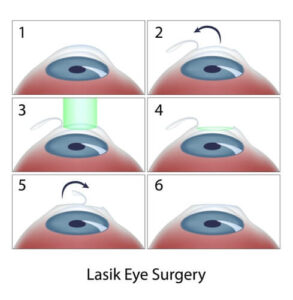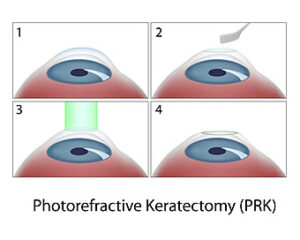Have you ever thought about undergoing a vision correction procedure? These procedures are an excellent alternative to traditional visual aids like glasses and contact lenses.
Undoubtedly, the most popular vision correction procedure is LASIK. Most people have heard of LASIK or even thought about having it at one time.
But LASIK isn’t your only option for permanently correcting your vision. Another similar procedure is PRK.
PRK is similar to LASIK in many ways, and both yield similar results, with most patients achieving 20/20 vision or better after the procedure. But although there are some similarities, there are also a few key differences.
Keep reading to learn more about how LASIK and PRK compare and find out which one may be right for you!
Refractive Laser Eye Procedures
LASIK and PRK are both refractive laser eye procedures. Both vision correction procedures use a laser to correct a refractive error.
Refractive errors, which include nearsightedness, farsightedness, and astigmatism, occur when the cornea is an irregular shape.

The cornea, the clear front of the eye, is what light refracts through. Refraction is the bending of light, and how light bends through your cornea affects how you see.
When the cornea is an irregular shape, it prevents light from bending through it correctly. Everything you’ll see is blurry if you’re looking at something too far away, too close, or in the case of astigmatism, at any distance.
Refractive laser eye procedures permanently change the shape of your cornea. Procedures like LASIK and PRK make it so you can see without the assistance of glasses or contact lenses.
Both LASIK and PRK use a special kind of laser called an excimer laser to sculpt the cornea to correct your specific refractive error. But the procedures differ in how the cornea is accessed.
LASIK

When you have LASIK, your New England Eye Center surgeon will create a flap in your cornea. They do this with another kind of laser called a femtosecond laser.
The femtosecond laser can separate tissue without penetrating the surface of that tissue, causing minimal damage to the cornea. The cornea gets lifted when the surgeon creates a flap with the femtosecond laser.
The excimer laser is used to access the corneal tissue beneath the flap. After that, the flap is replaced and acts as a natural bandage while your eyes heal.
Eventually, it will fuse back to the rest of the cornea without needing stitches to hold it in place. Creating the corneal flap is a large part of what sets LASIK apart from PRK.
The flap minimizes the invasiveness of the procedure, making healing more comfortable. Patients also often see immediate visual improvement, although they won’t see the full results of LASIK until their eyes fully heal.
Initial recovery from LASIK only takes a few weeks. Most patients only feel discomfort for the first day or two and start feeling better quickly.
During initial recovery, all you need to do is refrain from activities that may harm your eyes, like wearing eye makeup or using a pool or hot tub. After this period, you can resume life as usual and watch as your vision continues to improve until it reaches its peak once your eyes are fully healed, which takes 3-6 months.
As your eyes heal and recover, you’ll see your ophthalmologist for follow-up visits to assess your vision.
PRK

Although LASIK is the most popular elective procedure you can undergo, PRK came first. PRK predated LASIK and was the first kind of refractive laser eye procedure ever to become available to the public.
It’s still performed today because it’s just as effective as LASIK and is a good alternative for some patients. These patients may find out they aren’t good LASIK candidates or may not want to have LASIK for their own reasons.
What makes PRK different from LASIK is there is no corneal flap created. Instead of making a flap, the surgeon only removes the outer, protective layer that surrounds the cornea, called the epithelium.
The excimer laser then sculpts and reshapes the cornea directly. The epithelium regrows after only a few weeks. During this time, the patient wears a contact lens that acts as a bandage.
Initial recovery from PRK may take a little longer than LASIK because the epithelium needs to regrow. Some patients may also experience a little more discomfort.
You also may not experience immediate visual improvement. But, like LASIK, you’ll only need to refrain from certain activities for a few weeks, and your eyes will feel normal again while they heal and improve.
Also, like LASIK, you’ll see the full results of the procedure once your eyes finish healing. Most patients find that this takes about 3-6 months, with total recovery and peak vision improvements within a year.
Which Procedure is Right for You?

Although LASIK is a more well-known procedure, it doesn’t take away from the results that PRK can deliver. If you’re a LASIK candidate, this is what most patients choose.
However, if you don’t qualify for LASIK, it doesn’t mean that your dreams of visual freedom are over. One of the most significant factors for LASIK candidacy is corneal thickness.
If you want LASIK, you must have thick enough corneas to create a flap during the procedure. Having LASIK when your corneas aren’t thick enough can result in vision problems and other serious complications.
While most people have corneas of a sufficient thickness for LASIK, some don’t. PRK is an excellent alternative for these patients as it yields comparable results.
Are you ready to determine which vision correction procedure best fits you and your visual needs? Schedule your consultation at New England Eye Center in Boston, MA, to find out now!




